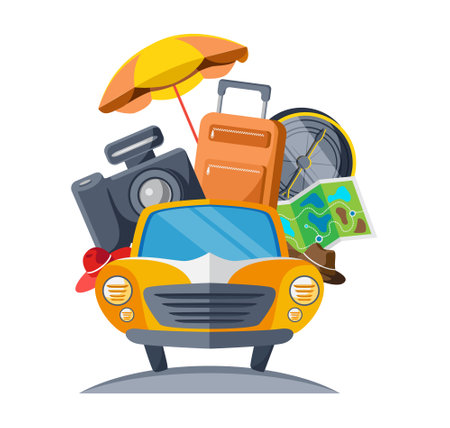1. Introduction to Seat Belt Laws
Seat belt laws are essential regulations in the United States that aim to enhance safety for drivers and passengers. These laws vary by state but generally require vehicle occupants to wear seat belts while the vehicle is in motion. By enforcing seat belt use, authorities aim to reduce injuries and fatalities resulting from car accidents.
Purpose of Seat Belt Laws
The main goal of seat belt laws is to protect individuals in the event of a crash. Studies have shown that wearing a seat belt significantly reduces the risk of injury or death in an accident. Seat belts help keep passengers securely in place, preventing them from being thrown forward or ejected from the vehicle.
Types of Seat Belt Laws
Seat belt laws in the U.S. can be categorized into two main types:
| Type | Description |
|---|---|
| Primary Enforcement | Police officers can pull over and ticket a driver or passenger solely for not wearing a seat belt. |
| Secondary Enforcement | Officers can issue a ticket for not wearing a seat belt only if the driver has been pulled over for another traffic violation. |
State-by-State Variations
Although federal safety organizations encourage seat belt use, enforcement and penalties vary by state. Some states have stricter seat belt laws with higher fines, while others have more lenient regulations. Understanding the laws in your state is crucial for ensuring compliance and safety.
The Impact on Road Safety
Enforcing seat belt laws has led to significant reductions in road fatalities and injuries. According to the National Highway Traffic Safety Administration (NHTSA), seat belts save thousands of lives every year. When used correctly, seat belts can reduce the risk of fatal injuries by approximately 45% for front-seat passengers in cars.
By following seat belt laws, drivers and passengers can contribute to safer roads and protect themselves from serious harm. Seat belts are a simple yet effective measure that enhances overall vehicle safety.
2. The Role of Seat Belts in Accident Prevention
Wearing a seat belt is one of the simplest and most effective ways to protect yourself while driving or riding in a vehicle. In the event of a crash, seat belts help to prevent serious injuries and fatalities by keeping occupants securely in place. Below, we will explore how seat belts reduce risks and why they are essential for road safety.
How Seat Belts Reduce Injury and Fatalities
During a collision, a vehicle comes to an abrupt stop, but anyone inside continues to move at the same speed until something stops them. Without a seat belt, this could mean striking the dashboard, windshield, or even being ejected from the car. A seat belt helps to slow your bodys movement, distributing the force of impact across stronger areas of the body, such as the chest and hips.
Key Benefits of Wearing a Seat Belt
| Benefit | How It Helps |
|---|---|
| Prevents Ejection | Seat belts keep passengers inside the vehicle, reducing the risk of fatal injuries. |
| Reduces Impact Force | They spread the force of a crash over stronger body parts, minimizing injury. |
| Keeps Occupants Properly Positioned | Proper positioning helps airbags work more effectively and protects the head and spine. |
| Prevents Collision with Interior Structures | Seat belts keep passengers from hitting the steering wheel, dashboard, and windows. |
Why Seat Belts Are Essential
Studies from organizations like the National Highway Traffic Safety Administration (NHTSA) have shown that wearing a seat belt reduces the risk of fatal injury by 45% for front-seat passengers. For light truck occupants, this number jumps to 60%. These statistics highlight the importance of seat belt use and the role they play in saving lives on the road.
Common Myths About Seat Belts
Some drivers and passengers believe that seat belts are unnecessary at low speeds or during short trips. However, most accidents happen close to home and often at speeds under 40 mph. Another misconception is that airbags alone are enough to prevent injury, but in reality, airbags work best when combined with seat belt use. Relying on airbags without a seat belt could lead to greater harm.
Final Thoughts on the Role of Seat Belts
Understanding how seat belts work can help more drivers and passengers make safe choices on the road. By consistently wearing a seat belt, we can significantly reduce the chances of serious injury or death in an accident. Laws mandating seat belt use exist to protect lives, and following them is a crucial step toward safer driving for everyone.

3. Legal Consequences of Not Wearing a Seat Belt
Wearing a seat belt isn’t just about safety—it’s also the law. If you or your passengers don’t buckle up, you could face penalties, fines, and even more severe legal consequences depending on where you are. Understanding these consequences can help you stay compliant and avoid unnecessary trouble.
Penalties and Fines
Every state in the U.S. has seat belt laws, but the fines and penalties for not wearing one vary. Some states impose only a small fine, while others have stricter penalties, especially for repeat offenses. Below is a general breakdown of seat belt violation consequences in different states:
| State | Primary or Secondary Law? | Typical Fine for First Offense |
|---|---|---|
| California | Primary | $162 |
| Texas | Primary | $25 – $250 |
| Florida | Primary | $30 |
| New York | Primary | $50 |
| Ohio | Secondary | $30 (driver), $20 (passenger) |
In states with primary enforcement, police officers can pull you over solely for not wearing a seat belt. In states with secondary enforcement, officers can only issue a seat belt ticket if they pull you over for another violation first.
Legal Repercussions
Beyond fines, failing to wear a seat belt could lead to other serious legal consequences, including:
- Higher Insurance Rates: Some insurance companies may increase your premiums if youre cited for not wearing a seat belt regularly.
- License Points: In some states, repeated seat belt violations can result in points against your drivers license, potentially leading to suspension.
- Liability Issues: If you’re involved in an accident while not wearing a seat belt, you might be held partially responsible for your injuries, reducing the compensation you can claim.
- Additional Penalties for Minors: If a child under the required age is not properly restrained, the driver may face higher fines and even child endangerment charges.
Why It’s Not Worth the Risk
Getting a ticket or paying a fine for not wearing a seat belt is inconvenient, but the real danger is the risk to your life. Buckling up takes just seconds but can save you from both financial and physical harm. Always make sure you and your passengers are securely buckled before hitting the road.
4. Common Myths and Misconceptions About Seat Belts
Despite overwhelming evidence that seat belts save lives, some people still believe in myths that discourage their use. Lets debunk some of the most common misconceptions about seat belts and understand why wearing them is essential for everyone in a vehicle.
Myth #1: “Seat belts are unnecessary for short trips.”
Many people think that if they are just driving a short distance, they don’t need to wear a seat belt. However, most car accidents happen close to home, often within a few miles. It only takes a second for an accident to occur, and wearing a seat belt significantly reduces the risk of serious injury or death.
Myth #2: “Seat belts do more harm than good in a crash.”
Some believe that seat belts can trap them or cause more injuries in an accident. The truth is that seat belts are specifically designed to protect you by keeping you in place and distributing crash forces across sturdier parts of your body. Without a seat belt, you are much more likely to be thrown from the vehicle, which can be fatal.
Myth #3: “Airbags make seat belts unnecessary.”
Airbags are designed to work alongside seat belts, not replace them. Without a seat belt, the force of an airbag deploying can cause serious injuries. The combination of seat belts and airbags provides maximum protection in the event of a crash.
Myth #4: “Im a good driver, so I dont need a seat belt.”
Even the safest drivers can’t control the actions of others on the road. Unexpected events like reckless drivers, mechanical failures, or hazardous road conditions can lead to accidents. A seat belt is your first line of defense against the unknown.
Myth #5: “Seat belts are uncomfortable and restrictive.”
Modern seat belts are designed for comfort and safety. If a seat belt feels uncomfortable, it may not be adjusted correctly. Most vehicles allow for height and tension adjustments to ensure a proper and comfortable fit.
Seat Belt Myths vs. Facts
| Myth | Reality |
|---|---|
| Seat belts are only needed on highways. | Most accidents happen on local roads at lower speeds. |
| In a crash, I can brace myself. | Crash forces are too strong for anyone to effectively brace themselves. |
| Seat belts increase the risk of injury. | Seat belts prevent serious injuries and reduce the risk of being ejected. |
| A seat belt will trap me in a fire or underwater accident. | Seat belts help prevent unconsciousness so you can escape quickly. |
| Wearing a seat belt is a personal choice. | Not wearing a seat belt endangers everyone in the vehicle. |
Understanding the truth about seat belts can help more people make the smart choice to wear them every time they get into a vehicle. Myths and misinformation should never stand in the way of safety.
5. Encouraging Seat Belt Compliance
Wearing a seat belt is one of the simplest and most effective ways to stay safe on the road. However, not everyone consistently follows this basic safety rule. Encouraging seat belt use among drivers and passengers can help create a safer driving culture. Here are some practical tips to promote seat belt compliance:
Set a Good Example
One of the most effective ways to encourage seat belt use is by always wearing yours. When drivers and front-seat passengers buckle up, others in the vehicle are more likely to do the same.
Make It a Non-Negotiable Rule
Establish a firm rule that the vehicle does not move until everyone is buckled up. Reinforce this consistently so that it becomes a habit for all passengers.
Use Gentle Reminders
Simple reminders can make a big difference. If a passenger forgets to buckle up, politely remind them before driving. Saying something like, “We’re not going anywhere until everyone has their seat belt on,” can be effective.
Highlight the Benefits
Many people respond better to positive reinforcement rather than fear-based messaging. Share the benefits of seat belt use, such as:
| Benefit | Explanation |
|---|---|
| Reduces Injury Risks | Seat belts help prevent serious injuries in case of a crash. |
| Saves Lives | Studies show that seat belts significantly lower the risk of fatal accidents. |
| Legal Requirement | Not wearing a seat belt can lead to fines and penalties in most states. |
| Sets a Good Example | Encouraging seat belt use helps children and new drivers develop safe habits. |
Leverage Technology
Modern vehicles come equipped with seat belt reminders and alarms. These features can help reinforce compliance. Additionally, apps and in-car monitoring systems can provide seat belt alerts for parents with teen drivers.
Encourage Peer Accountability
Passengers can remind each other to buckle up. When everyone in the vehicle takes responsibility, it creates a culture of safety.
Use Incentives
When teaching young drivers or children about seat belt use, consider small rewards for consistently buckling up. Positive reinforcement can help turn seat belt use into a lifelong habit.
Address Common Excuses
Some people avoid wearing seat belts due to myths or discomfort. Addressing these concerns directly can help:
| Excuse | Response |
|---|---|
| “Im just driving a short distance.” | Most accidents happen close to home. Always buckle up, no matter the distance. |
| “Seat belts are uncomfortable.” | Adjusting the seat belt position properly can improve comfort. |
| “Im a good driver.” | Even the best drivers cant control other drivers on the road. |
| “I don’t need it in the back seat.” | Unbelted back seat passengers can be thrown forward in a crash, endangering everyone. |
Final Thought
Developing a habit of seat belt use saves lives. By promoting awareness and making seat belt use an unbreakable habit, we can all contribute to a safer driving culture.


